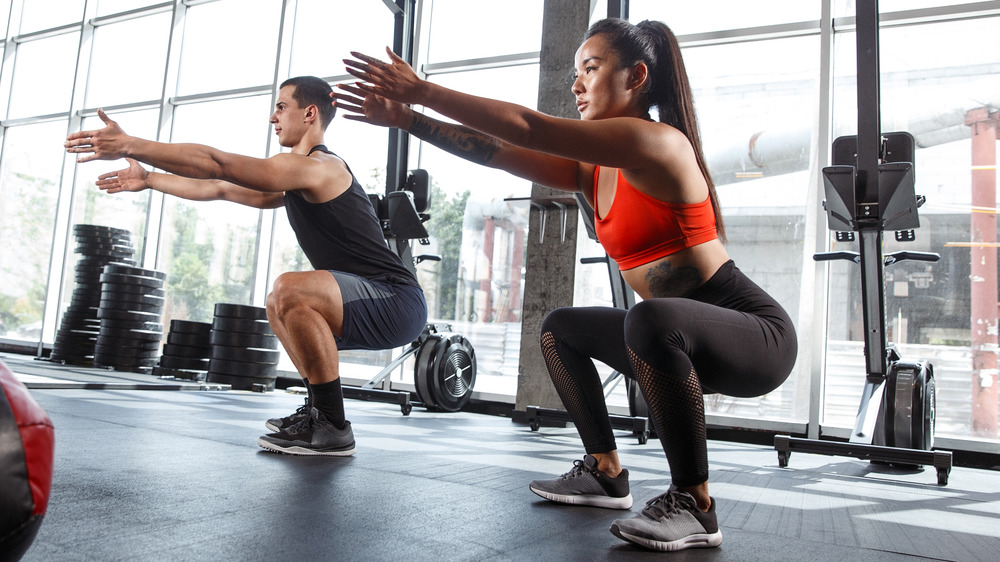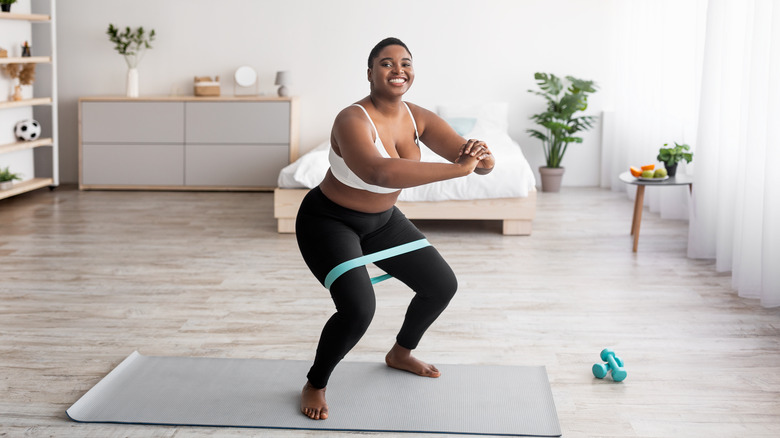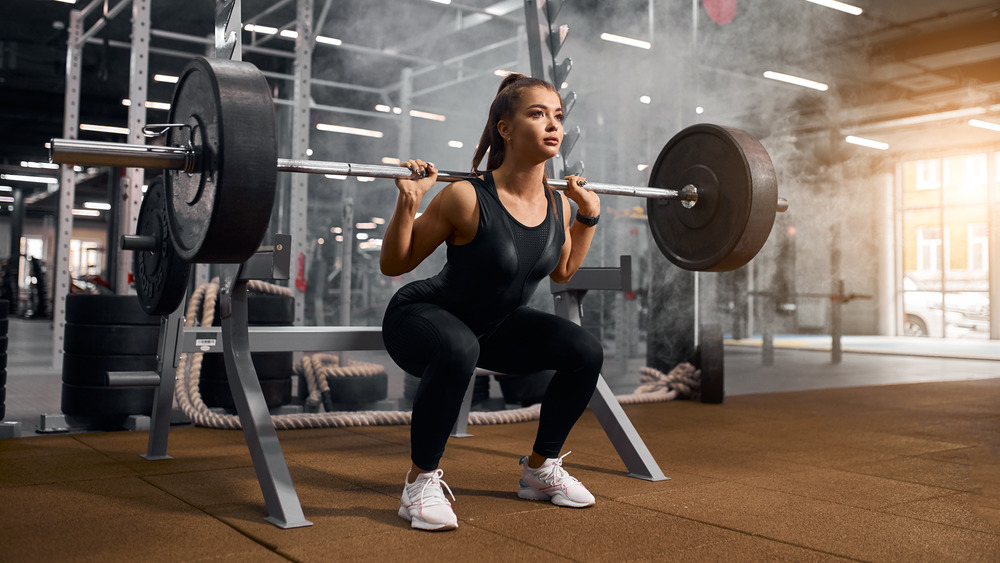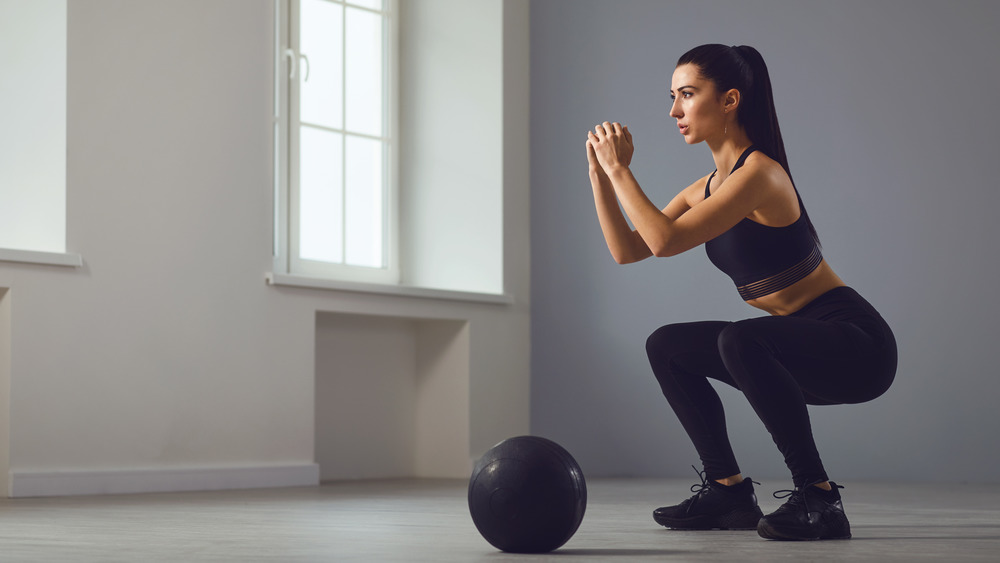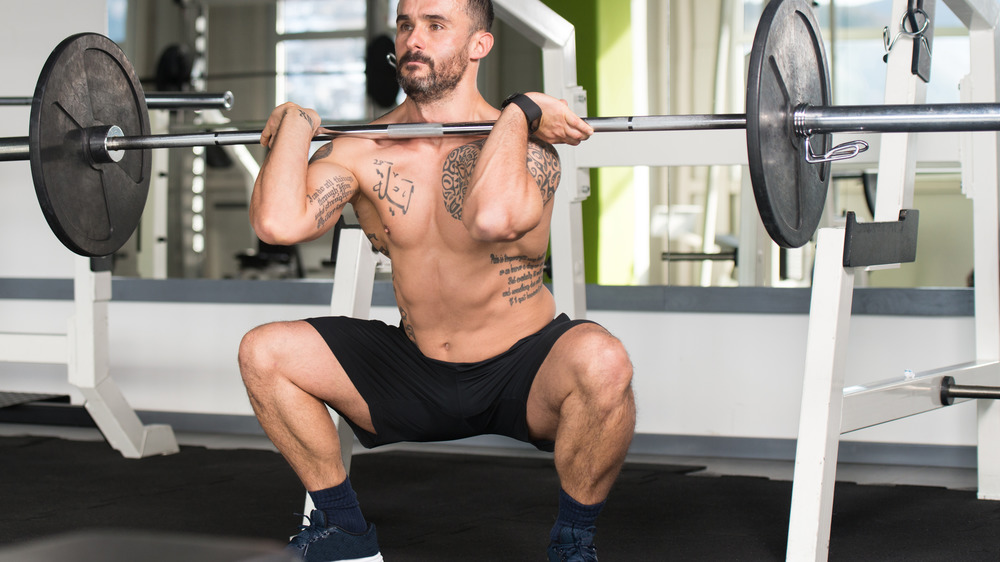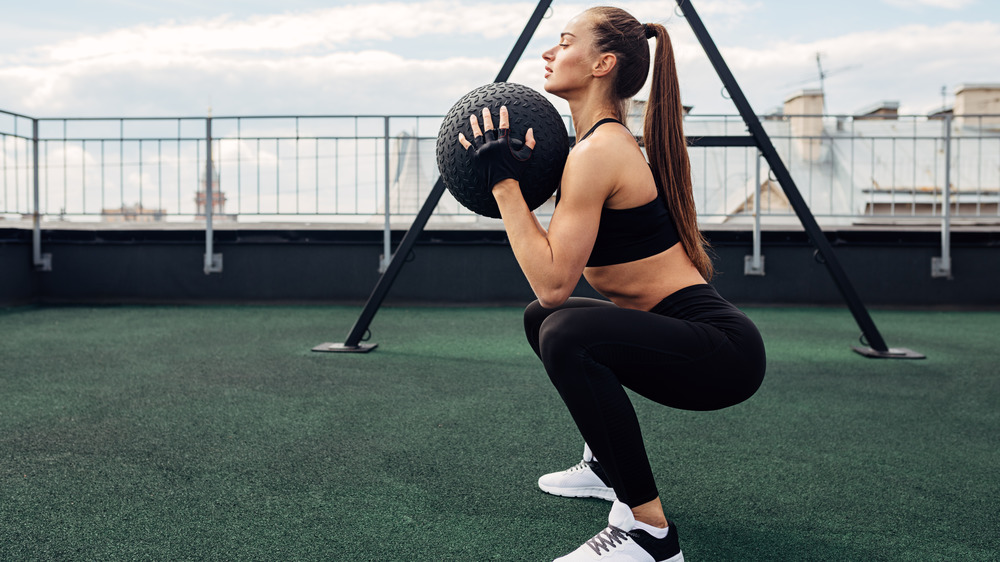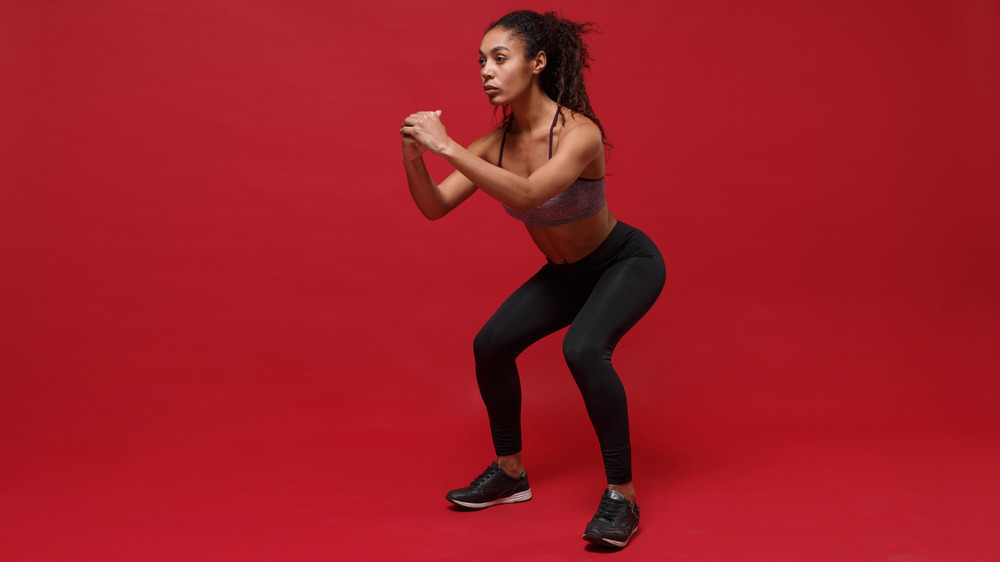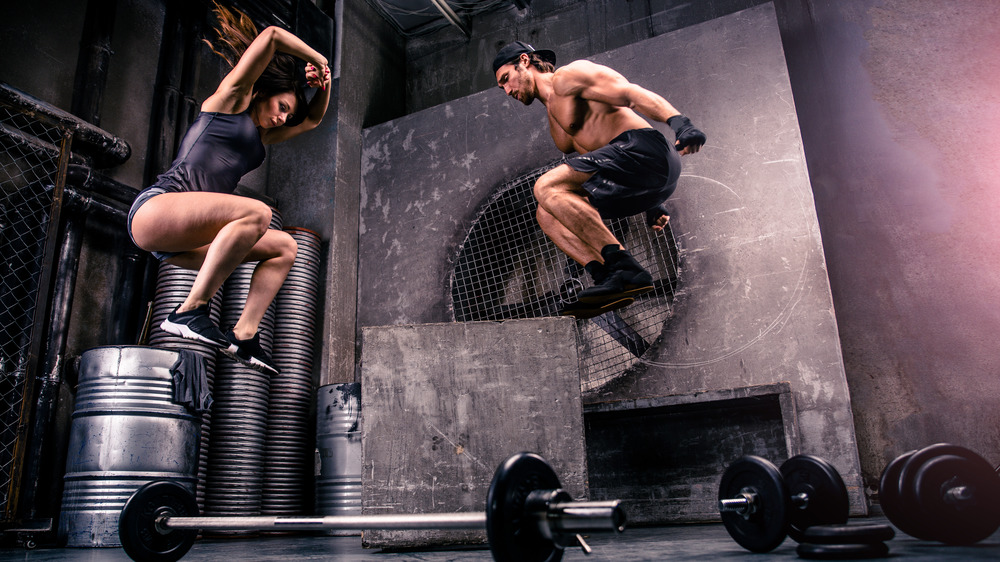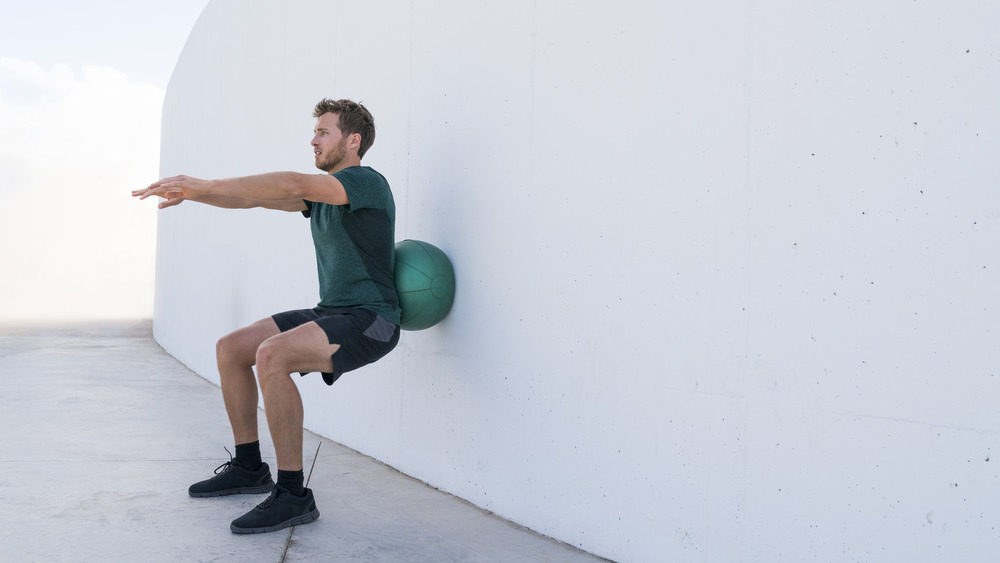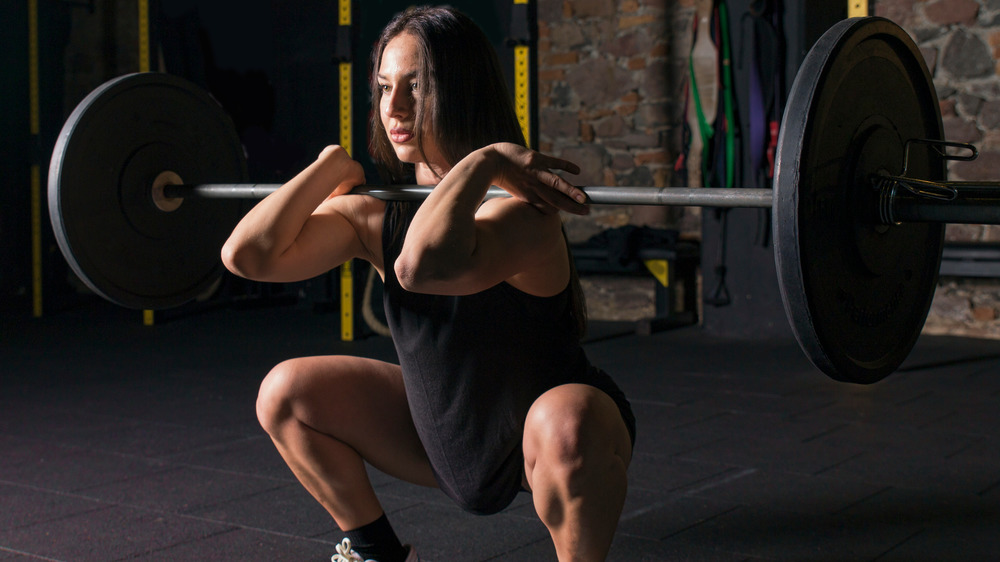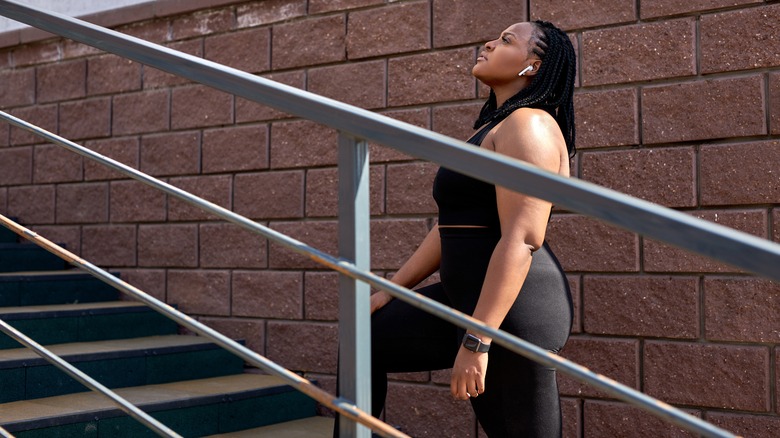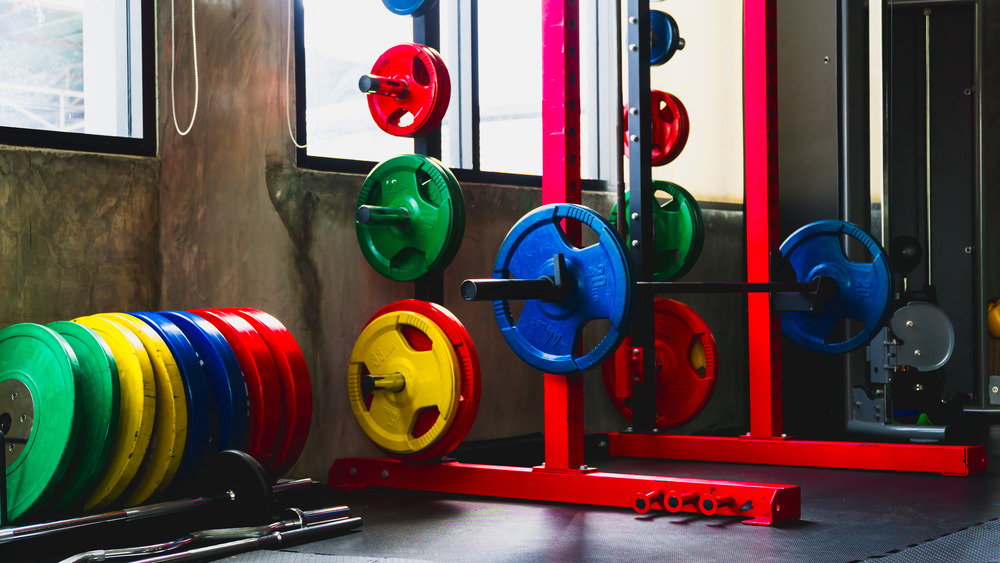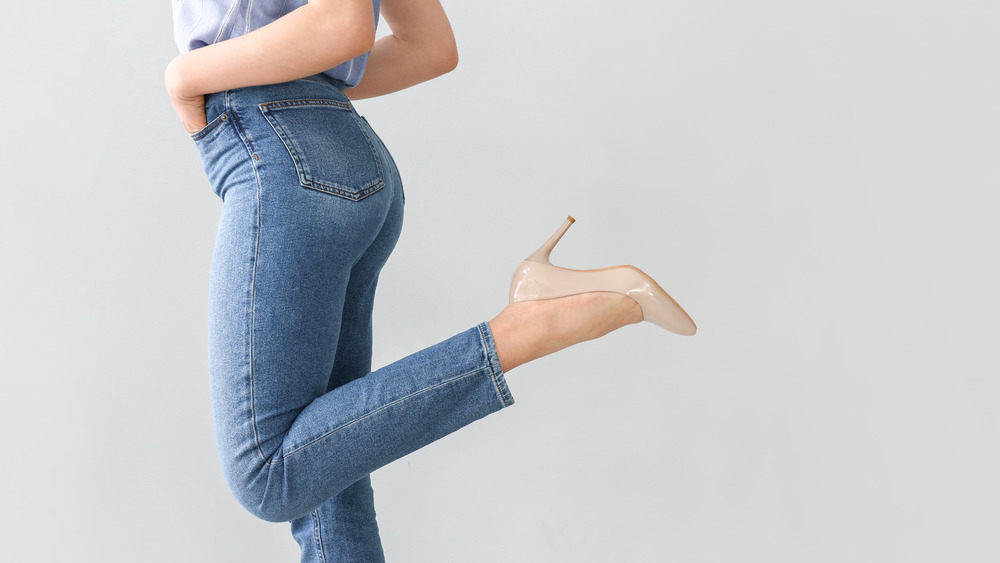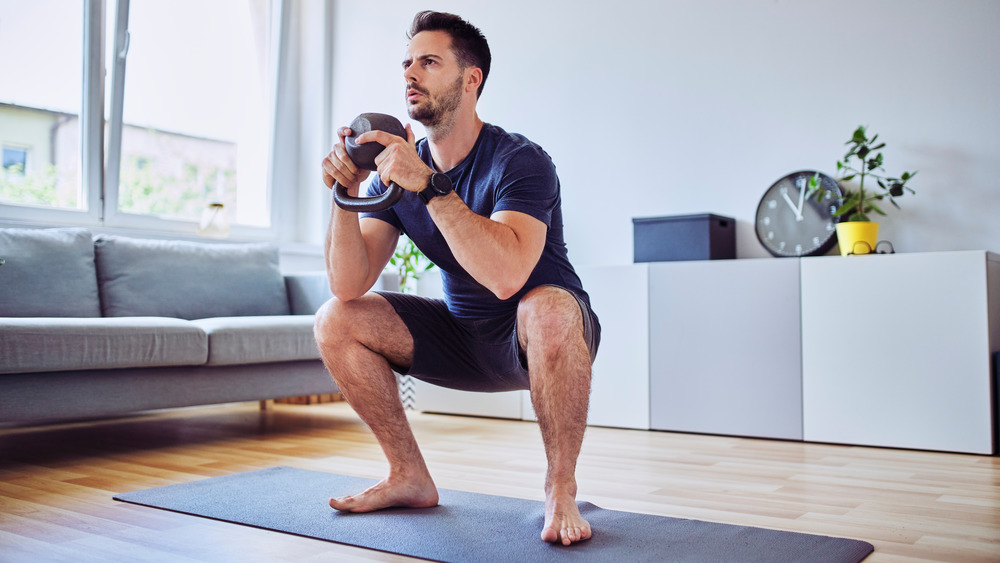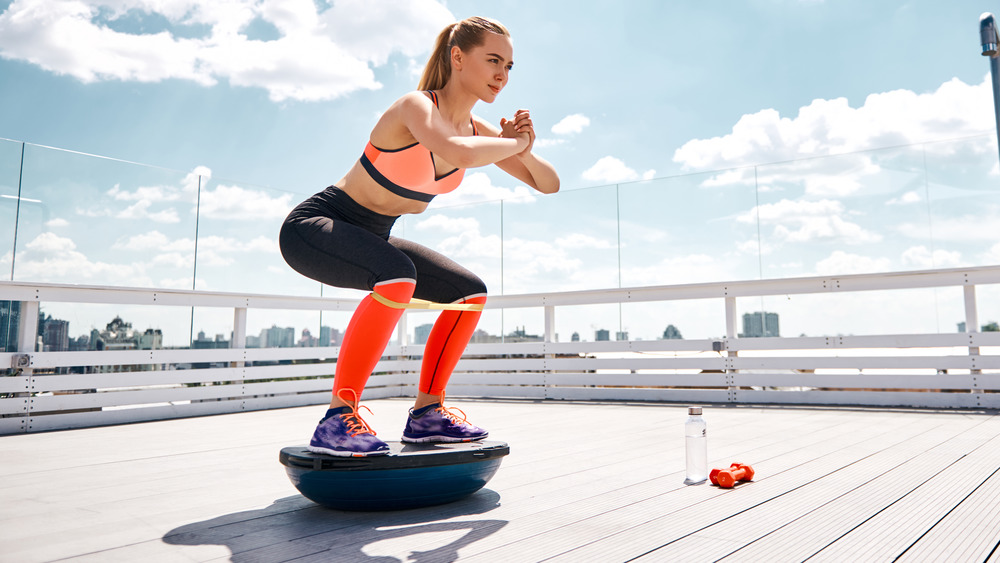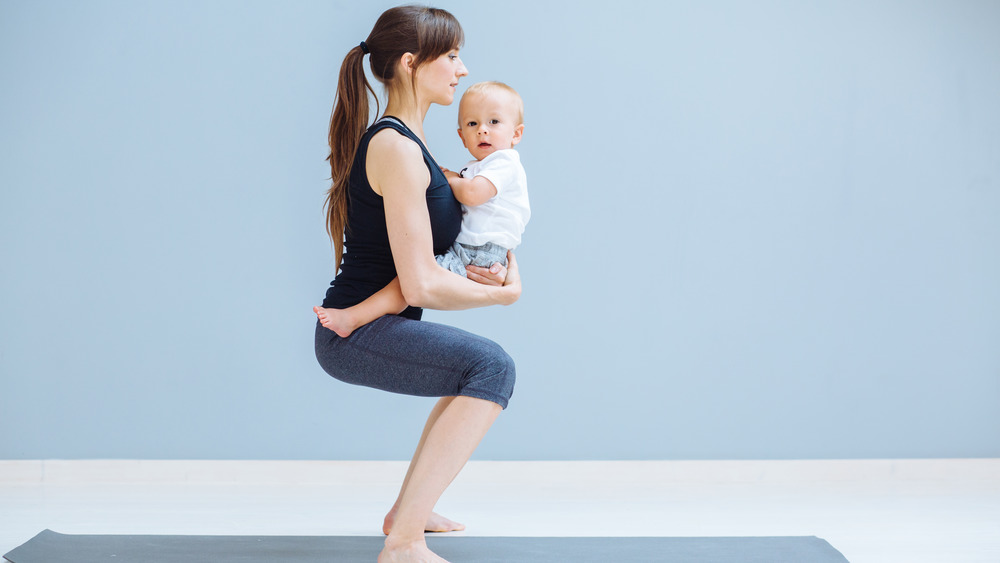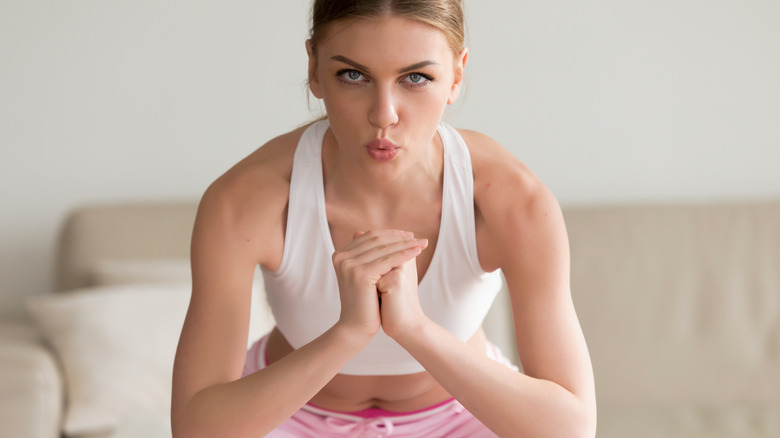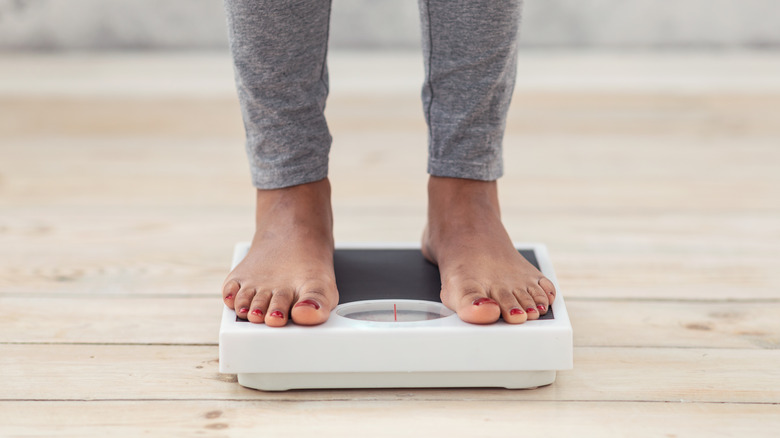When You Do Squats Every Day, This Is What Happens
Squats are considered a lower-body compound exercise. Essentially, this means they target multiple muscle groups, requiring that the muscles work together in a coordinated fashion to complete the movement. Just think about it: As you squat, you're asking your quads, glutes, and hamstrings to work together to do the bulk of the "lifting," coordinating the bending and extending at the hips and knees. But you're also engaging your calves, core muscles, and even your back and shoulders to maintain proper form and alignment to protect your joints from injury as you move.
Compound exercises, like squats, carry many benefits. For one, they translate to movements in everyday life. If you're strong enough to squat at the gym, you'll be able to take that strength and use it when you're getting out of bed in the morning or squatting down to pick something up off the ground. But as Healthline pointed out, compound exercises also burn more calories (because they target multiple muscles), improve coordination, improve strength and flexibility, and increase muscle mass. If you decide to add squats to your daily or regular routine, here's what you can expect.
Is it okay to squat every day?
Squats are a weight-bearing exercise. They recruit muscles throughout the body and help train them for many tasks that you perform every single day, as certified strength and conditioning specialist Ryan Andrews wrote for Precise Nutrition. These muscles help you from the moment you stand up in the morning to the moment you sit down on your bed at night.
However, squatting is just one of many forms of exercise that you should consider mixing in with a variety of others, including some that are aerobic in nature and therefore target your cardiovascular health and some that help keep your muscles supple and flexible, according to Texas Family Fitness. But if you can manage to work squats into your workout schedule every single day, should you?
Squatting every day is, in fact, generally considered safe, certified personal trainer Rozalynn S. Frazier explained in an article for Livestrong. Still, there are some factors to keep in mind, including whether performing squats will be at the expense of other important workouts you might be doing, what your goals are at any given time, and how well your body functions without rest between workouts or between days of performing the same exercise. If you're up for squatting every day, though, you can rest assured that there's typically little risk involved.
You'll build lower body muscles by squatting every day
Squats quite literally target every major muscle group of your butt (the three gluteus muscles), legs (hamstrings, quadriceps, and calves), hips (abductors, adductors, and hip flexors), and core (your abdominals, spinal erectors, and the smaller, stabilizing muscles of your hips), according to Precision Nutrition. When you perform a squat with proper form, taking the movement through a full range of motion, you're going to see improvements in muscular strength and endurance in all of these muscle groups over time.
Plus, if you switch things up and experiment with squat variations, like a back squat (supporting a weighted barbell across the back of your shoulders) or an overhead squat (holding weights above your head with your arms fully extended), you're also going to challenge the muscles of your shoulders, arms, chest, and back, as pointed out by Healthline.
When incorporated into your regular workout routine, using squats to improve the muscular strength of your lower body can pay off in day-to-day life. You may find that activities like walking up stairs or chasing after your kids starts feeling easier as your strength improves.
Daily squats will boost your metabolism
Squats can boost your metabolism in several ways (via Self). First, whenever you exercise, the larger the muscle groups you use, the more calories you're going to burn during a workout. Muscle is considered a metabolic tissue, so by targeting big muscle groups, like the glutes, hamstrings, and quads, you'll end up revving your metabolism more than when you use smaller muscles.
Second, as you build more muscle, you'll feel stronger and be more capable of lifting heavier weights or hiking longer distances. Marie Spano, a strength coach and registered dietitian told Self, "Gaining muscle through resistance exercise means you can do more. You can work out harder and hike steeper trails. This will lead to an increase in calories burned."
Finally, targeting large muscle groups and building more muscle mass as a whole means that you'll be able to boost your metabolism around the clock. As strength coach K. Aleisha Fetters explained in the article for Self, a pound of muscle burns about six calories per day, while a pound of fat burns about two calories. That doesn't sound like much, but as you gain muscle and lose fat, those extra calories start adding up.
You'll strengthen your core by doing squats every day
Even though squats primarily target the legs, the exercise actually requires a fair amount of core stabilization and engagement, which with time, will help strengthen the muscles of your abdomen and low back. But, as pointed out by strength coach Avi Silverberg in an article for Powerlifting Technique, squats shouldn't completely replace your core workouts. This is because the core is made up of several different muscle groups, including the ab muscles (like the rectus abdominis, transverse abdominis, and the obliques) as well as the erector spinae, which works to stabilize and extend your spine.
Squats appear to be better at developing erector spinae strength than a plank exercise, but the plank proves to be better at developing the rectus abdominis — the "six pack muscles" — than the squat. In other words, different exercises target the core in different ways. Squats can definitely help you build core strength, as a whole, which can help reduce the risk of injuries and improve athleticism, but they're unlikely to help you carve the six pack you've been craving.
You'll build your bones with daily squats
One of the effects of aging is the gradual thinning of bone tissue (via Mount Sinai). With time, bones become more porous and fragile, which can lead to conditions like osteopenia and osteoporosis. Many people don't give these diseases a second thought — it's "normal" for grandma to lose a little height and become more frail with age, right? The problem, though, is that osteoporosis, in particular, can make a person more likely to suffer fractures, according to the National Osteoporosis Foundation. This becomes particularly challenging when the bone in question is the hip or spine — fractures in these areas can lead to drastic, difficult-to-overcome changes in lifestyle.
One of the most effective ways to keep bones strong and to even stimulate bone tissue growth in adulthood is to perform strength training exercises. And, according to a 2013 study published in the Journal of Strength and Conditioning Research, postmenopausal women with osteoporosis who performed heavy squats three times a week for 12 weeks saw an increase in bone mineral content of the spine and femoral neck (where the leg meets the pelvis). As such, the study concluded that "MST [maximal strength training] can be implemented as a simple and effective training method for patients with reduced bone mass."
Doing squats daily may reduce your risk of injury
You may have heard that squats are "bad" for you — that they can hurt your knees or cause back pain. And certainly, if you perform a squat wrong, or if you lift more weight than you're prepared to lift, injuries can and will occur. But when done with proper form, the strength you develop from doing squats can actually help prevent injuries from occurring.
According to a 2020 study published in the Journal of Strength and Conditioning Research, among college athletes who were tested for their relative maximum squat strength (adjusted based on the athlete's weight), those who had more relative strength compared to their peers were less likely to suffer a lower extremity injury during their athletic season. This is likely due to the benefits of compound exercises, like squats, on lower body strength, core strength and spinal stability, control, coordination, and overall athleticism. The strength and coordination developed from doing squats is highly transferrable to other actions and could pay off when it comes to avoiding injury when performing other activities.
Daily squats may improve your athletic performance
Doing squats on the daily may improve your athletic performance (via Stack). Granted, this benefit is going to be related only to elements that squats help target. For instance, you may develop more power and be able to move faster and more explosively thanks to the new muscles squats have helped you develop in your glutes, quads, and hamstrings. But if your goal is to be able to swing a golf club more effectively or to improve your hand-eye coordination for playing softball, well, squats aren't likely to help you much with those skills.
As Josh Williams, a strength and conditioning coach, wrote for Stack, "There's no proof that the squat will make you better at sport-specific skills, unless your sport is weightlifting. What the research does show is that the squat is effective at preparing your body for sports that require power output, strength, and speed. It just so happens that the majority of sports require power, strength, and speed."
Switching up your squats will keep your workout interesting
If you're doing basic air squats every single day, chances are you're going to get bored (via Well+Good). Plus, unless you keep increasing your repetitions, it's going to become harder to keep seeing results. Muscles grow when you continue to challenge them and make them adapt to new stimuli, as Verywell Fit explained. After a few weeks of doing three sets of 12 air squats, your muscles are going to find the exercise much easier to perform, and you're unlikely to keep seeing gains.
The beauty of squats, though, is that there are so many variations and different ways to make the basic squat more interesting (and challenging). For instance, Healthline provided 45 different variations that you can try. Some use added weight — like dumbbells, kettlebells, and barbells to increase resistance — while others require no equipment at all. For instance, a side kick squat (with or without added weight) is an excellent way to work on balance and coordination while also strengthening your abductors to help you perform the side kick.
You'll improve your posture by doing squats every day
Squatting, in general, is good for developing core strength, particularly through your spinal erectors, which help with spine extension. This alone can help improve posture with time (assuming you're performing squats with proper form). But certain squat variations, particularly those that require a more upright positioning of the torso, like overhead squats or front squats, can also help strengthen the shoulders and upper back, which can further improve posture.
Healthline explained that the overhead squat — in which you're holding a weight with both hands directly over your head — is particularly good for strengthening the shoulders, arms, and upper back, in addition to the legs and lower back. However, it is particularly important to pay attention to your form during overhead squats. To avoid bad form or injury, you really have to squeeze your shoulder blades toward your spine and pull your shoulders back and down to prevent your torso from tipping forward, which could cause the weight to shift too far in front of your body.
The actions of retracting your shoulders and lifting your chest are great ways to counteract the common culprits of poor posture — forward-rounded shoulders and chest, and a forward-tilted head.
You'll find it easier to walk up stairs after implementing a squat routine
As your lower body and core get stronger from knocking out all those daily squats, you may find that your day-to-day life just feels... easier. Maybe climbing up a couple flights of stairs or trekking in bags of groceries would leave you huffing and puffing for a few minutes, but now you're breezing through these motions.
As Katrina Pilkington, and NASM-certified personal trainer told Women's Health, "So many actions can stem from the movements of a squat, from picking up your toddler to loading boxes into the house after a delivery. If you work to perform squats on a regular basis, using form that is on-point ... you're sure to build a strong foundation for functional movement."
And really, that's what working out should be all about. Yes, you want a booty that looks good in your skinny jeans, but the ultimate "win" from knocking out a bunch of squats is when you start realizing how much more energy you have to get through life. And when you have energy to spare at the end of the day, guess what? You can throw that energy into your workouts and keep seeing greater results.
You'll need to add more weight or reps to keep seeing results
Here's the thing about resistance training: The stronger you get, the more resistance you have to keep adding to see results. That means if you're doing squats every day, you're going to need to mix things up and add more resistance on a regular basis.
As Kisar S. Dhillon, a personal trainer based in Portland, Oregon, wrote for Active, "If you have been doing a certain weight ... and you're able to complete the sets and repetitions after two weeks, it's time to increase your resistance." Dhillon suggests increasing the weight you're lifting by 5 to 10 percent.
Remember, though, that there are ways to increase resistance and difficulty to your squats without adding more weight. For instance, you can start doing a front squat or overhead squat instead of a traditional air squat. You can try your hand at a single-leg squat. Or you can simply increase the number of repetitions you're doing with each set. The point is to keep mixing it up and pushing yourself. When a set and rep scheme starts to feel easy, it's time for a change.
Squats can make your butt and legs bigger
The thing about strength training is that it causes your body to undergo quite a few changes. As you boost your metabolism and burn more calories, you may start losing fat and dropping weight. At the same time, you may be building more muscle mass, adding more definition and shape to specific areas. In regards to squats, those areas will most likely include your glutes, hamstrings, and quads.
As Kelli Segars, a personal trainer and founder of Fitness Blender, wrote for the site, "Like many people, I used to avoid strength training because I didn't want to 'get bulky.' Once I ditched that mentality and began lifting ... my weight dropped, my shape changed." She went on to highlight that squats, specifically, can change the appearance, shape, and size of your butt and thighs. While some areas might get comparatively larger, and others might get comparatively smaller, the end result from regularly squatting will be a tighter, more shapely lower body — which just might benefit from a few new pairs of jeans to show off your derriere.
You can improve your flexibility by doing squats daily
Most people don't naturally correlate strength training with flexibility. In fact, you may be under the impression that lifting weights can hinder flexibility — if your muscles get "bulkier," doesn't that make it harder to move around? The reality is that strength training, particularly when moving through a full range of motion, can actually improve flexibility.
As part of a study performed by James R. Whitehead of the University of North Dakota and presented at a meeting of the American College of Sports Medicine, subjects were assigned to a strength training group, a stretching group, or to a group without intervention. Those who strength trained saw greater hip flexibility improvements than the other two groups, and equal hamstring flexibility improvements compared to the stretching group (via WebMD). And it actually makes a lot of sense, as William Lunn, exercise scientist told WebMD, "Look at Olympic weight lifters. They're extremely powerful lifters, but they're also extremely flexible."
You can improve your balance with squats
In addition to building strength and flexibility in the muscles and joints of your lower body, squatting on the daily can also help you improve your balance. The key, though, is choosing squat variations that are designed to focus on this component of fitness (via Body Building). For instance, single-leg squats force you to move through the squatting motion while balanced on one leg. This is particularly challenging as your center of gravity moves, and you have to make adjustments to your body's positioning throughout the squat in order to maintain good form and balance.
Likewise, squats that use a balance training tool, like a BOSU ball, can also help you improve your balance, even when performed on two legs (via Healthline). This is because the unstable nature of the surface requires more engagement of the smaller, stabilizing muscles of your ankles, hips, and even your core, to keep the balance tool level and your body position stable. If you're looking to improve your balance, consider Healthline's list of squat variations, and focus on those that use equipment or that target one leg at a time.
Labor and delivery might be easier thanks to squats
If you're pregnant and dreading labor and delivery, squatting regularly just might make that part of the process a little bit easier. Not only is regular exercise good for you and your baby, strengthening the muscles of your glutes, hips, and core (particularly your core) make pushing during childbirth a little bit easier. Most specifically, as NASM-certified personal trainer Katrina Pilkington told Women's Health, doing squats also helps strengthen your pelvic floor.
According to OB-GYN Kelly Morales' website, a strong pelvic floor is essential to a healthy pregnancy, childbirth, and postpartum recovery. "Starting out your pregnancy with strong pelvic floor muscles helps decrease the damage these muscles experience under the strain of carrying a growing child," she explained. "A healthy pelvic floor also makes labor and delivery less risky, as you'll be better equipped for labor, which means less stress for your baby."
Just remember: While exercise is generally considered healthy and safe during pregnancy, if you weren't exercising before you became pregnant, talk to your obstetrician to make sure you're cleared to get started.
Do squats reduce body fat?
Much of the energy our bodies use is available in the form of calories from the foods that we consume (via Medical News Today). When we consume more calories than our bodies need to function, our fat stores may increase. That actually comes in handy during times when the calories that we have consumed are not sufficient to support our energy needs. Other sources include the muscles of the body. That's why weight loss is often not only the loss of fat but also, to some degree, the loss of muscle mass (via Healthline).
The action of squatting demands a certain amount of energy from the body, which can lead to weight loss. This doesn't mean you can spot-reduce body fat or spur weight loss from a specific area of your body, but squats will indeed help you build more muscle and burn fat all around, according to Livestrong.
How long do squats take to show results?
How long it will take to see results depends on how you define "results." If your goal is generating feelings of well-being, then results may be immediate (via Fast Company). If your goal is weight loss, you may start to see ounces lost the first time you step on a scale after you start a squatting program, per Inspira Health Network.
It may take some weeks for you to notice increased muscle tone, according to Dark Iron Fitness, which points out that results also depend upon your body's size and composition (e.g., muscle versus fat ratio), hormone levels, and diet. Also, as personal trainer Sarah Rector told Byrdie, "The more regularly you do squats, the more results you will see." Generally, though, you should see results from strength training (including squats) within 12 weeks, Kristin Haraldsdottir, director of Exercise Research & Innovation at Hydrow, told Insider.
